January 2010
Decade in Review: The Industrial Market
 John Cash, SIORExecutive Vice President / Managing Director
John Cash, SIORExecutive Vice President / Managing Director
NAI Hiffman
As we begin a new decade and as 2009 recedes into the rearview mirror, we find ourselves at an opportune moment to look back on a remarkable and turbulent decade in industrial real estate. A fitting quote to describe the first 10 years of the new century is Charles Dickens’ famous, “It was the best of times, it was the worst of times”.
In January 2000, investors were riding on the edge of the dot-com bubble with buoyant exuberance. The NASDAQ stock index broke 5000 in March 2000 just before the market began a precipitous plunge. The following year, with a recession looming, the nation was struck with the terrible tragedy of 9-11 which led to two costly and enduring wars.
The resilient American economy rebounded by mid-decade despite a declining manufacturing sector. Unfortunately, a new speculative bubble soon formed in the financial and real estate sector fueled by low interest rates, high leverage and plentiful equity. Again, the bubble burst, this time beginning in the housing sector and spreading throughout the commercial markets.
This era of financial chicanery, beginning not long after the repeal of the Glass-Steagall Act in 1999, introduced us to new jargon including: subprime loans, credit default swaps, derivatives and collateralized debt obligations. As the U.S. plunged into recession in 2008, additional terminology entered the lexicon including: credit crunch, financial meltdown, bailout, and TARP funds. In 2009, unemployment jumped to 10 percent. The entire underpinning of the economy was in doubt. Yet by the end of 2009, signs of a nascent recovery became evident with a positive turn in GDP growth, increased industrial production, rising home sales and an improving stock market. What a ride it has been.
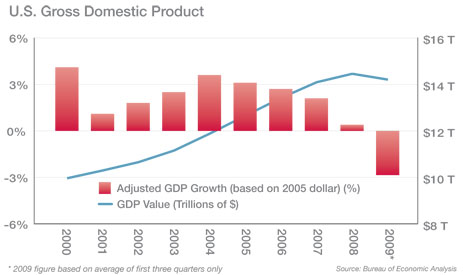
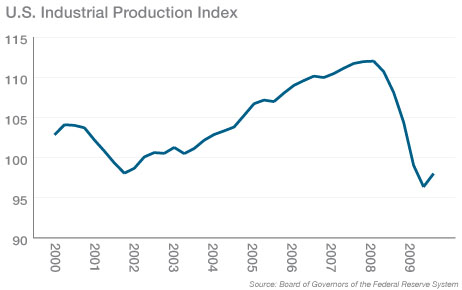
Industrial Development
Chicago’s industrial market has experienced similar peaks and valleys during the past decade. As the nation’s second largest industrial market, it has undergone many remarkable changes. As a drive along any major expressway will confirm, the past decade was a boom period for industrial development. The industrial base of the metropolitan area was approximately 1.05 billion SF in 2000. This number grew by 150 million SF (14 percent) to nearly 1.2 billion SF by 2009. New construction deliveries averaged 15 million SF per year with the majority occurring along the I-55 and I-80 corridors.
Market turmoil and difficulty in obtaining credit led to the cancellation of virtually all planned industrial development projects in the second half of 2008. The Chicago market is anticipating few new construction starts before 2012.
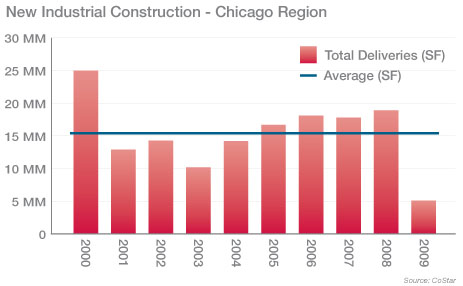
Product Evolution
Speculative construction constituted the majority of new industrial product over the past 10 years. Speculative buildings in the 400,000 SF range began to emerge in 2000. The scale of these facilities trended upward peaking in 2007 with several buildings exceeding 1 million SF.
Building specifications evolved to include clear heights exceeding 30 feet, a larger number of dock doors and more trailer storage. New florescent lighting, increased roof insulation, energy efficient positive pressure heating systems and other features of LEED certified development standards were adopted by many industrial developers.
Market Trends
The low cost of capital, combined with declining cap rates, led to gradually contracting industrial lease rates for the first half of the decade which eventually leveled off by 2006. Industrial sales grew steadily in volume and average price until 2007. This was followed by a precipitous 74 percent decline in sales volume over 2008 and 2009.
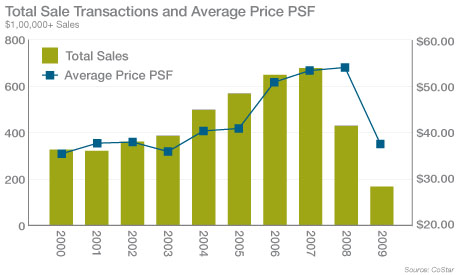
Lack of absorption of new product and significant vacancies combined with the weakening economy pushed the industrial vacancy rate to 12 percent in 2009, the highest level since 1991.
REITs and Institutions
Industrial acquisition and development was primarily driven by growing equity inflows resulting from increased institutional real estate allocations prompted by the steep stock market declines of the early decade.
Private investors also sought portfolio diversification by investing in REITs. Formed in the 1990’s as an efficient vehicle for investors to place equity in real estate through share purchase, REITs grew dramatically during the first decade of the century. Initially, the REITs focused on existing portfolios, but later moved into land acquisition and development.
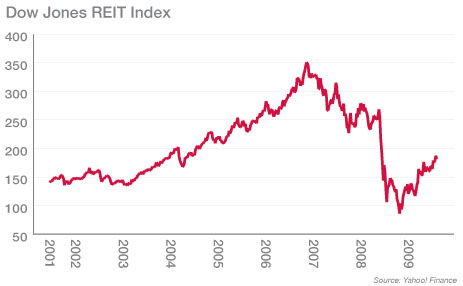
The market turmoil of 2008 and 2009 struck the industrial REITs hard with stock valuation declines exceeding 90 percent, on average, by the low point reached in March 2009. Fortunately, the major industrial REITS have demonstrated their resilience by successfully recapitalizing and de-levering their portfolios while increasing their occupancy rates. Renewed investor confidence is evident in the stabilized share values.
Capital Markets
The strong inflow of institutional and private equity into industrial real estate, combined with a vibrant market, drove speculative construction and pushed down cap rates on portfolios. Cap rate compression facilitated a decline in rental rates despite higher sale prices and production costs.
For class “A” product, industrial cap rates were close to nine percent in 2000 and declined to below six percent as the market peaked in 2007. As recent transactions have been few and far between, current cap rates are difficult to ascertain, but indications are that we ended the decade where we started, with cap rates approaching the nine percent level.
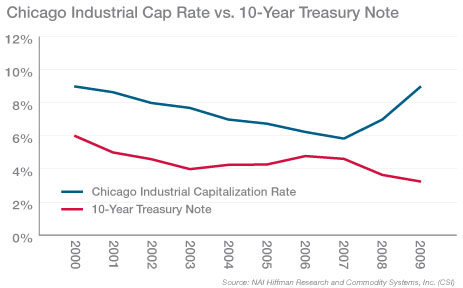
Regional Market
Chicago’s strategic geographic location and transportation infrastructure make it one of the most important transportation centers in the country. Located in the path of three of the nation’s busiest transcontinental expressways, Chicago also claims 70 percent of the nation’s rail and intermodal activity.
Over the past decade, Chicago’s preeminence in transportation has become even more apparent with the CenterPoint-sponsored development of the BNSF Logistics Park Chicago and the UP Joliet Intermodal Center. These two logistics centers and their surrounding industrial components will occupy 6,000 acres when fully developed.
These two projects effectively constitute the nation’s largest inland port where eventually several million TEUs of import and export product will pass annually. Both the BNSF Logistics Park Chicago and the UP Joliet Intermodal Center link directly to Port of Los Angeles and the Port of Long Beach, providing efficient transportation for both imports and exports to Asia.
The perception of Chicago has changed, from large local market to a super regional market in just 10 years. The increased efficiency of the Chicago rail infrastructure combined with the direct competition of the BNSF and UP railroads will increase Chicago’s market share and prominence in the nation’s supply chain.
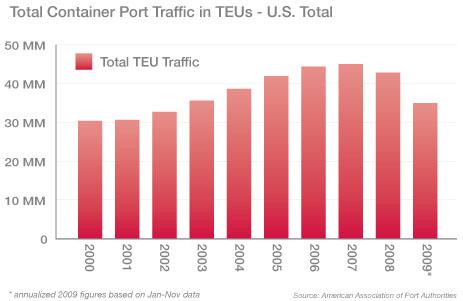
Global Competition
The percentage of the U.S. gross domestic product attributable to foreign trade has increased from 25 percent to 31 percent over the last decade. Trade between the U.S. and China has grown over 200 percent over the same period, directly correlating with the dramatic rise of China as the world’s leading exporter. The prevalence of goods “Made in China” sold throughout the U.S. marketplace attest to the growing success and influence of China.
Persistent and significant U.S. trade deficits with China have also made China the world’s leading holder of U.S. debt estimated at a staggering $1 trillion and rising. As a result, it is likely that China will emerge as a significant investment force in the U.S. over the coming decade.
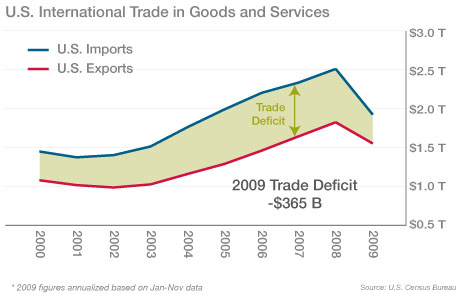
China’s very low labor costs, currency controls, and government incentives have made it very challenging for domestic U.S. manufacturers to compete. These advantages, combined with an increase in “outsourcing” or “offshoring”, have resulted in a significant contraction of U.S. manufacturing capacity over the past decade. As is the case throughout the country, employment and value-creation produced by the manufacturing sector are in decline. Build-to-suits for manufacturing companies, common throughout the 1980s and 1990s, became significantly less frequent over the past decade. Nevertheless, Greater Chicago still remains the country’s leading manufacturing region.
The Road Ahead
The United States remains the world’s largest economy with a gross domestic product of over $14 trillion annually. The U.S. is also the third most populous country after China and India. Population throughout the country is projected to grow from 310 million today to over 450 million by 2050. The Chicago region is projected to add 2.5 million people over the next 40 years, approximately 600,000 people per decade. Regardless of the current economic travails, over time the regional economy and population will continue to grow and, subsequently, drive real estate development. Chicago’s premier transportation network and diversified economy will continue to provide opportunities for industrial development over the decade to come.


